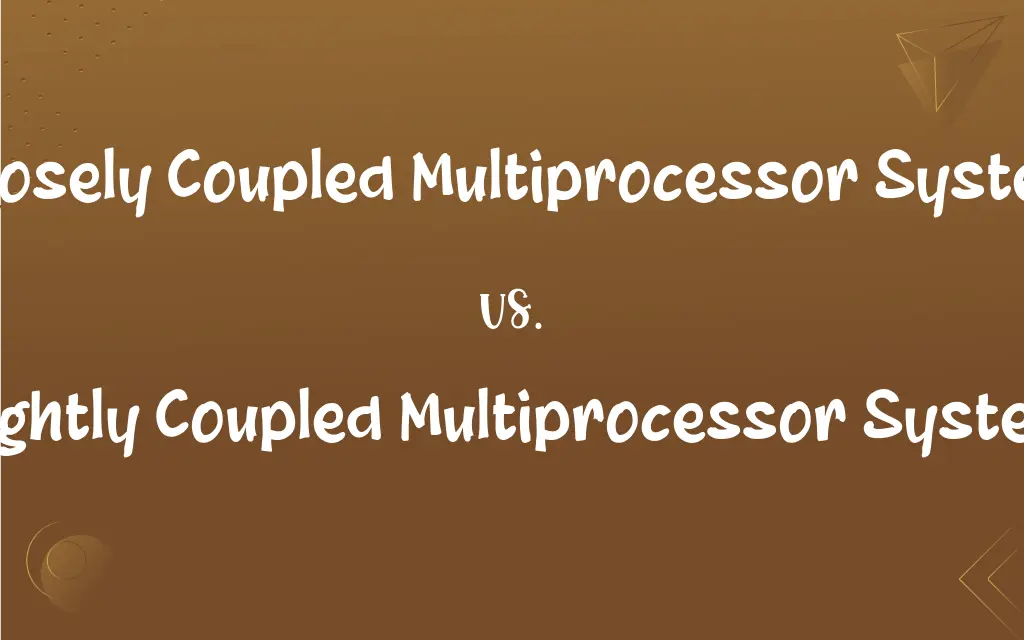Loosely Coupled Multiprocessor System vs. Tightly Coupled Multiprocessor System: What's the Difference?
Edited by Aimie Carlson || By Janet White || Published on February 23, 2024
A loosely coupled multiprocessor system consists of independent CPUs with separate memory, communicating over a network, while a tightly coupled system has multiple CPUs sharing the same memory and bus.

Key Differences
A loosely coupled multiprocessor system features multiple processors that operate independently, each with its own memory and operating system. These processors communicate over a network, often using message passing. In contrast, a tightly coupled multiprocessor system consists of several processors sharing a single memory and operating system. These processors are interconnected through a bus that allows them to access shared memory efficiently.
In a loosely coupled system, the independence of processors allows for high fault tolerance; the failure of one processor doesn’t halt the entire system. In a tightly coupled system, processors are interdependent, and a failure in one can affect the whole system, making fault tolerance lower compared to loosely coupled systems.
Scalability differs significantly between the two systems. Loosely coupled systems are more scalable because new processors can be added without significant changes to the existing architecture. Tightly coupled systems, however, have limited scalability due to the shared memory and bus architecture which can become a bottleneck with too many processors.
Performance-wise, tightly coupled systems often have higher performance for shared-memory applications due to faster data access and communication between processors. On the other hand, loosely coupled systems might have slower inter-processor communication but are better suited for distributed applications where tasks are independent.
The loosely coupled system is typically used in applications where tasks are discrete and can operate independently, such as in grid computing. In contrast, tightly coupled systems are often employed in applications requiring intensive data processing and fast access to shared data, like in complex scientific computations.
ADVERTISEMENT
Comparison Chart
Processor Independence
High - processors operate independently.
Low - processors share resources.
Memory Architecture
Separate memory for each processor.
Shared memory accessible by all processors.
Scalability
Highly scalable with minimal architecture change.
Limited scalability due to shared resources.
Fault Tolerance
High - failure of one processor doesn’t affect others.
Lower - processors are interdependent.
Typical Applications
Suitable for distributed applications.
Ideal for shared-memory intensive tasks.
ADVERTISEMENT
Loosely Coupled Multiprocessor System and Tightly Coupled Multiprocessor System Definitions
Loosely Coupled Multiprocessor System
These systems excel in tasks that can be divided into discrete, autonomous units.
In a loosely coupled multiprocessor system, each node in a grid computing network operates autonomously.
Tightly Coupled Multiprocessor System
It features processors connected via a bus, enabling efficient shared memory access.
A supercomputer uses a tightly coupled multiprocessor system for fast data processing and analysis.
Loosely Coupled Multiprocessor System
Characterized by its decentralized architecture with minimal inter-processor dependency.
A loosely coupled multiprocessor system allows a server farm to handle distinct requests independently.
Tightly Coupled Multiprocessor System
Characterized by high inter-processor communication speed due to shared resources.
In a tightly coupled multiprocessor system, real-time data processing is enhanced by rapid memory access.
Loosely Coupled Multiprocessor System
A system where multiple independent processors perform tasks without shared memory.
A cloud computing platform often uses a loosely coupled multiprocessor system for distributed data processing.
Tightly Coupled Multiprocessor System
Ideal for applications requiring intensive computation and quick data sharing.
A tightly coupled multiprocessor system is crucial in weather forecasting models for simultaneous data computations.
Loosely Coupled Multiprocessor System
It comprises processors with individual memory, communicating via a network.
A loosely coupled multiprocessor system is used in scientific research for parallel processing of independent experiments.
Tightly Coupled Multiprocessor System
A system with multiple processors sharing the same memory and operating system.
A tightly coupled multiprocessor system is often used in high-performance computing for complex simulations.
Loosely Coupled Multiprocessor System
Offers high fault tolerance as the failure of one processor doesn’t affect the others.
A loosely coupled multiprocessor system in a data center ensures continuous operation even if one server fails.
Tightly Coupled Multiprocessor System
Less scalable due to the complexities of shared memory management.
Expanding a tightly coupled multiprocessor system is challenging due to the shared memory architecture.
FAQs
What is a tightly coupled multiprocessor system?
Multiple processors sharing the same memory and operating system.
Is scaling a tightly coupled system straightforward?
No, it's challenging due to shared resource complexities.
Can you scale a loosely coupled system easily?
Yes, it's highly scalable with minimal architecture change.
What defines a loosely coupled multiprocessor system?
Independent processors with separate memory, connected over a network.
How do these systems differ in fault tolerance?
Loosely coupled systems offer higher fault tolerance.
What's the typical application for a loosely coupled system?
Ideal for distributed and independent task applications.
How do these systems handle processor communication?
Via network in loosely coupled, and shared bus in tightly coupled.
What about memory architecture differences?
Separate for each processor in loosely coupled, shared in tightly coupled.
What advantage does a tightly coupled system offer?
Faster data processing due to shared memory access.
Can loosely coupled systems handle real-time processing effectively?
They're less effective compared to tightly coupled systems.
What's a major advantage of a loosely coupled system?
Its ability to continue operation even if one processor fails.
Where would you use a tightly coupled system?
In applications requiring shared-memory intensive computations.
How does processor independence vary between these systems?
High in loosely coupled, low in tightly coupled systems.
Are loosely coupled systems more energy-efficient?
Yes, generally they are more energy-efficient due to independent operation.
Do tightly coupled systems require more power?
They often consume more power due to shared resource management.
How does a loosely coupled system affect overall system performance?
It offers stable performance but with potentially slower inter-processor communication.
What kind of network is used in loosely coupled systems?
They typically use a local area network (LAN) or wider networks for communication.
Is there a cost difference between these systems?
Loosely coupled systems can be more cost-effective, especially when scaling.
Are tightly coupled systems good for distributed applications?
They're less suitable than loosely coupled systems for this purpose.
What impact does a tightly coupled system have on performance?
It enhances performance for shared-memory tasks but can be a bottleneck for scalability.
About Author
Written by
Janet WhiteJanet White has been an esteemed writer and blogger for Difference Wiki. Holding a Master's degree in Science and Medical Journalism from the prestigious Boston University, she has consistently demonstrated her expertise and passion for her field. When she's not immersed in her work, Janet relishes her time exercising, delving into a good book, and cherishing moments with friends and family.
Edited by
Aimie CarlsonAimie Carlson, holding a master's degree in English literature, is a fervent English language enthusiast. She lends her writing talents to Difference Wiki, a prominent website that specializes in comparisons, offering readers insightful analyses that both captivate and inform.







































































